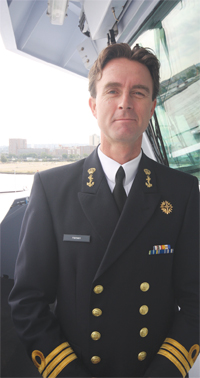Commander Walter Hansen attended the DSEi exhibition in London in September 2013 along with his, then yet-to-be-commissioned ship, Holland class patrol vessel HNLMS Groningen. Patrick Boniface caught up with Commander Hansen to talk about his ship and his career.
When did you join the Dutch Navy?I joined in 1985 at the Royal Naval College as a midshipman and I graduated in 1988, although my family has no maritime background. I did my tour on ships as Officer of the Watch and Air Defence, which included serving on the frigate HNLMS Callenburgh and the minesweeper HNLMS Hoogeveen. I did more tours as Operations Officer on the frigate HNLMS Piet Heyn, the air defence frigate HNLMS Jacob Van Heemskerck and as Executive Officer of the multi-purpose frigate HNLMS Van Ness.
What is it like to be in command of such a modern and capable warship?I feel privileged to be in charge of such a ship. It is not just the ship, but a combination of the crew and the ship. You can always have a good ship, but you also need a good crew, and we have a dedicated group who make the picture complete.

How do you motivate them?I think there are two issues on motivation. You have to be approachable as a captain, and you have to be transparent. You also have to be quite clear what you allow people to do and what you don’t allow them to do. You have to be very strict in one way and, in my opinion, you have to tell people what you expect of them, what the aim is, what the mission is, but you don’t have to tell them how to do the job, because that is what they have to figure out for themselves; you only give them some guidelines.
Tell us about your ship.She was designed on what we call the Naval Study 2005, which specified replacements for a couple of frigates. We were to replace them with ships which are specifically designed to do everyday tasks, which we do 90 per cent of the time, with our role being maritime security. That involves counter piracy, counter drugs, border patrols in Europe and the Caribbean and a lot about safety at sea. We can also render assistance with our fast interceptors and helicopter, and with the storage facilities we have on board. In the storage hold we can operate an emergency hospital and even put in a decompression tank and cooling containers for food supplies ifnecessary.
There is a lot of innovation in the ship’s design, including the layout of the bridge and operations room. The operations room is just in front of the bridge and provides us with more space, as well as being the communication centre. In the old-fashioned ships the ops room was deep inside the ship. Looking at the tasks I described earlier, we have quite a good sensor fit, which enables us to gain situational awareness. We have the same radar as an old frigate. We cannot deploy any missiles, and our main assets are the helicopter, which can be on deck at any time, and the two fast interceptors. They are our main weapon systems. We have a huge crane, which can lift up to 25 tons, and we can store two containers. So our weapons are not missiles or guns, but rather the assets that we can bring to our taskings.

Read A View From The Bridge every month in Ships Monthly – subscribe here


